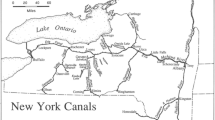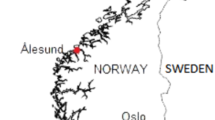Abstract
A random effects stochastic frontier variable cost function is estimated for the Erie Canal and nine interconnected lateral canals in New York, covering the period 1837–1881. Variable costs are 50 % above least cost for the Erie and 42 % above across all the 10 canals. Inefficiency does not vary over time in response to numerous changes in canal administrative structures and personnel or the advent of railroads. The canal system was plagued by documented waste, fraud and mismanagement throughout its history. A privatized, price capped Erie Canal was proposed in 1817, but rejected on political grounds.
Similar content being viewed by others
Notes
A generic variable cost function is VC(Q, w, K), where Q is an output vector, w an input price vector and K is fixed capital (Kumbhakar and Lovell 2000, p. 61). The estimated Cobb–Douglas cost function is log linear.
The Auditor’s report of 1856 (p. 75) shows about one-third of operating costs related to the canal locks. Other significant functional categories include repairs to tow paths and walls (19 %), miscellaneous and tools (14 %), canal cleaning and repair of leaks (12 %), salaries (9 %), and bridge and aqueduct repairs (5 %).
The final report of the Auditor of the Canal Department appeared in 1882, which summarized the revenues, operating and maintenance expenses, cost of construction and improvements and net results (exclusive of interest) up to 1881. These numbers are repeated in the Report of the Committee on Canals (1900) and in Whitford (1906), suggesting that 1881 was deemed the end of the original canal era in New York. The Auditor’s responsibilities were transferred to the State Comptroller; and the canals became another taxpayer funded government department.
Four outlier estimates of \(u_\mathrm{it}\, > \,1\) were examined for data errors. In three instances Crooked Lake costs suddenly increased dramatically, but the numbers used are verified as those appearing in canal records. In the other instance, Black River tons of freight fell suddenly, but that figure is also what appears in official canal documents.
These are the Chemung, Chenango, Genesee Valley, Crooked Lake and Oneida Lake.
Prior to 1844 it appears there were six appointed canal commissioners. From 1844–1847, there were four commissioners, two of whom were elected statewide. From 1848–1878 there were three commissioners and all were elected statewide.
A proposed tax on land along the route of the canal was not implemented.
In one instance a contractor (Ryal Briggs) assigned his repair contract to a third party, Willard Johnson, two days before the contract itself was awarded, supposedly by competitive bidding. This prior assignment was signed and dated by canal officials (p. 71).
Although repairs by contractors ended in 1870, private contractors were used for canal construction and capital improvements throughout the period under investigation.
Another variable that indicated change in membership on the board of canal commissioners proved collinear with the number of commissioners and was dropped.
References
Bernstein, P. L. (2005). Wedding of the waters. New York: W.W. Norton.
Braeutigam, R. R., & Daughety, A. F. (1983). On the estimation of returns to scale using variable cost functions. Economics Letters, 11(1–2), 25–31.
Cranmer, H. J. (1961). Improvements without public funds. In C. Goodrich (Ed.), Canals and American economic development (pp. 115–168). New York: Columbia University Press.
Demsetz, H. (1968). Why regulate utilities? Journal of Law and Economics, 11(1), 55–65.
Engerman, S. L., & Sokoloff, K. L. (2004). Digging the Dirt at Public Expense: Governance in the Building of the Erie Canal and Other Public Works. NBER working paper 10965 (December). Cambridge, MA: National Bureau of Economic Research.
Greene, W. (2005). Reconsidering heterogeneity in panel data estimators of the stochastic frontier model. Journal of Econometrics, 126(2), 269–303.
Greene, William. (2007). Limdep computer program: Version 9. Plainview, NY: Econometric Software.
Kumbhakar, S. C., & Lovell, C. A. Knox. (2000). Stochastic frontier analysis. New York: Cambridge University Press.
New York (State) Legislature. (1847). Report of the Select Committee of the Assembly of 1846 Upon the Investigation of Frauds in the Expenditure of Public Moneys Upon the Canals of the State of New York. Assembly Document 100. Albany, NY: Charles Van Benthuysen & Co.
New York (State) Legislature. (1856). Annual report of the auditor of the canal department, relative to the expenditures on the canals. Assembly Document 213. Albany, NY: Charles Van Benthuysen & Co.
New York (State) Legislature. (1868). Senate select committee to investigate into the management of the canals of the State of New York. Senate Document 13. Albany, NY: C. Van Benthuysen & Sons.
New York (State) Legislature. (1882). Annual report of the auditor of the canal department, showing the expenditures on the canals. Assembly Document 33. Albany, NY: Weed, Parsons and Co.
New York (State). (1894). The constitution of the State of New York, with notes references and annotations. (Cumming, R.C., Potter, O.L. & Gilbert, F.B. (Eds.)). Albany, NY: J.B. Lyon Co.
New York (State). (1900). Report of the committee on canals of New York State. Assembly Document 79. Albany, NY: J.B. Lyon Co.
Rubin, J. (1961). An innovating public improvement: The erie canal. In C. Goodrich (Ed.), Canals and American economic development (pp. 15–66). New York: Columbia University Press.
Shaw, R. E. (1966). Erie water west: A history of the Erie Canal, 1792–1854. Lexington, KY: University Press of Kentucky.
Smith, W. B. (1963). Wage rates on the Erie Canal, 1828–1881. Journal of Economic History, 23(3), 298–311.
Vining, A. R., & Boardman, A. E. (1992). Ownership versus competition: Efficiency in public enterprise. Public Choice, 73(2), 205–239.
Vitaliano, D. F. (2005). Estimation of the return on capital in municipal water systems. National Tax Journal, LVIII, 4, 685–695.
Warren, G. F., & Pearson, F. A. (1933). Prices. New York: Wiley.
Whitford, N. E. (1906). History of the canal system of the State of New York (Supplement to the Annual Report of the State Engineer and Surveyor of the State of New York for the Fiscal Year Ending September 30, 1905). Two Volumes. Albany, NY: Brandow Printing.
Author information
Authors and Affiliations
Corresponding author
Rights and permissions
About this article
Cite this article
Vitaliano, D.F. Public Enterprise Efficiency: The Case of the New York Canals. Rev Ind Organ 46, 169–182 (2015). https://doi.org/10.1007/s11151-014-9448-6
Published:
Issue Date:
DOI: https://doi.org/10.1007/s11151-014-9448-6




